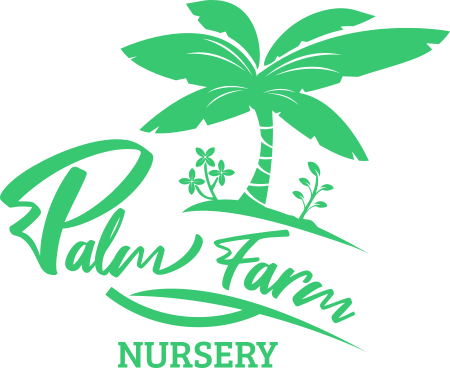Agroforestry
Bare ground is vulnerable – Plant Trees and gain an income
What is Agroforestry?
Agroforestry is the land management system where trees and shrubs are integrated into crop and animal farming systems to create economic, social and environmental benefits.
Agroforestry provides opportunities for landowners – both commercial and small-scale farmers, for better productivity and profitability but is particularly crucial to smallholder farmers and other rural groups because it enhance their food supply, income and health.

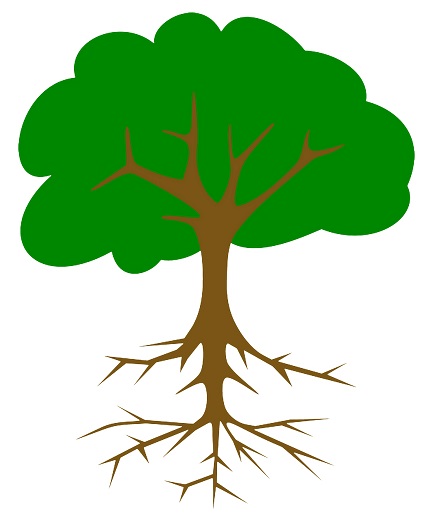
Agroforestry is farming in 3D
and it works because – trees above ground protect crops and animals against the elements and roots reach deep into the ground to cycle. Therefore, Agroforestry can solve many problems concerning intensive farming.
Benefits for Farmers
Increase Crop Yields: Trees provide shade and shelter for crops, reducing stress from harsh weather conditions. They also help to fix nitrogen in the soil, making it more fertile for crops.
Diversify Income Streams: Farmers can generate additional income by selling fruits, nuts, timber, or other tree products. Agroforestry can also provide firewood, fodder for livestock, and other products that farmers would otherwise need to purchase.
Reduce Risk: By having multiple sources of income, farmers are less vulnerable to fluctuations in crop prices or poor harvests.
Environmental Benefits
Improve Soil Health: Trees help prevent soil erosion by anchoring it with their roots. They also add organic matter as leaves and branches decompose, enriching the soil and improving its ability to retain water.
Enhance Biodiversity: Agroforestry systems create a more complex habitat than monoculture farming, providing food and shelter for a wider variety of wildlife.
Water Quality Protection: Trees help to filter rainwater, reducing runoff and improving water quality.
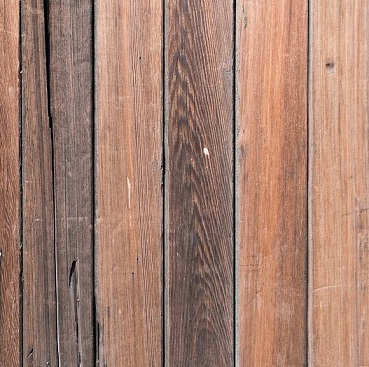
A large, fairly fast-growing, evergreen tree, The wood is dark, hard, reddish brown and durable, suitable for furniture, flooring, panelling, and excellent for boat building, moderately heavy, with an attractive grain. Popular as a source of firewood and charcoal. Charcoal made from red mahogany wood has a long burning time with a gentle and steady heat. Red mahogany is perfect for using in integrated farming systems for crop production. Leaves and twig litter decomposition improve soil fertility and organic matter status of the soils that lead to an improvement in crop yield output.
Suitable to grow in most soil types, also tolerant of swampy soils. The wood weathers well and is resistant to borers and termites.
1 m tree K100
1.5 m tree K180

Black Mulberry tree
Very easy to grow, fruit is very nutritious with many medicinal properties and can be eaten fresh out of hand or to make jams, pies, tarts, puddings, Silvopasture, Leaves are highly palatable and digestible, an excellent protein-rich fodder for livestock and can be used as supplements replacing concentrates for dairy cattle, it increase milk production of lactating goats, cows, sheep and rabbits, and improve livestock productivity.
Full sun, will thrive in degraded soils but prefers compost-rich, well-drained soil, very drought tolerant, fast growing, resistant to all major pest and diseases.
1 m tree K100

White Mulberry tree
Very easy to grow, fruit is very nutritious with many medicinal properties and can be eaten fresh out of hand or to make jams, pies, tarts, puddings, Silvopasture, Leaves are highly palatable and digestible, an excellent protein-rich fodder for livestock and can be used as supplements replacing concentrates for dairy cattle, it increase milk production of lactating goats, cows, sheep and rabbits, and improve livestock productivity.
Full sun, will thrive in degraded soils but prefers compost-rich, well-drained soil, very drought tolerant, fast growing, resistant to all major pest and diseases.
1 m tree K100

Ochroma pyramidale (Balsa Tree)
A large, extremely fast-growing tree, Balsa wood is the softest of all the hardwood, and super lightweight, one of the lightest varieties of wood available, but remarkably strong, it is considered the strongest wood for its weight in the world, used in model-building, packing, flotation devices, insulation lining for incubators, refrigerators and cold storage rooms, wind turbine blades, table tennis rackets, hobby and craft projects, toys, doll houses, doll furniture, carving and whittling. Balsa wood is lighter than cork and thus ideal for life preservers and lifebelts, wooden crankbaits for fishing, especially Rapala lures and floats for fishing nets and lines. Excellent for making biochar has great water holding capacity. Harvest in 8 to 9 years.
Balsa is a pioneer species that thrives on abandoned land, recommended for the recovery of degraded areas and soil improvements. Fast leaf turnover increases the soil organic matter content. The flowers provide abundant food for bats, birds and several insects. The seed fibre is used as stuffing for mattresses and cushions. In aeronautic modelling, Balsa Wood is very much in demand as it is a perfect wood that can easily withstand crash landings and does not cause any major damage. Valued as a component of full-sized light wooden airplanes.
1 m tree K100
1.5 m tree K180
2 m tree K320
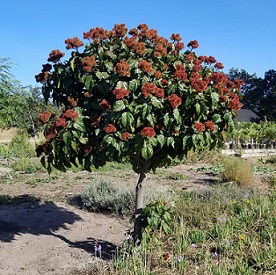
Bixa orellana (Lipstick tree)
Gorgeous small, evergreen tree, pink flowers and scarlet heart-shaped seed pods, high anti-oxidant content, many medicinal properties, used to colour and flavour foods, colour fingernail polish, shoe polish, floor wax, hair oil, lacquer, varnish, soap, cosmetics, furniture, ointments and leather, grown commercially in tropical countries, lovely garden shrub, long flowering period. Harvesting starts in 2 years.
Full sun to partial shade, average water, drought tolerant, any soil, Grows 2 to 5 m tall, Seed yields 0.5 – 2 tonnes/ha per year. 20 – 50g of dye can be obtained from 1 kg of seed. Trees are productive for 16 to 20 years.
1 m tree K100
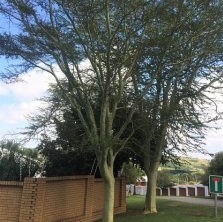
Acacia/Vachellia xanthophloea (Fever Tree)
Attractive, semi-deciduous, tall, fast-growing, distinctive, smooth lime-green branches and stem, bark is slightly flaking, powdery surface. Used for construction and carpentry, firewood, produce high quality charcoal, flowers produce good bee forage, feathery leaves can be fed to livestock, improves soil fertility by nitrogen fixation
Full sun, Partial shade, Average water to moist, Deep, fertile, sandy soil, 10 – 15 metres tall, Evergreen if watered through winter, Non-aggressive roots
1 m tree K100
1.5 m tree K180
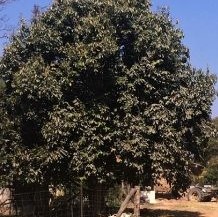
Dense shade tree used in large gardens and parks, also a popular street liner, Makes a terrific indoor plant if placed near bright light
Used for firewood, charcoal, Popular wood for woodcarving in eastern and southern Africa, seed oil is used for soap, candles, cosmetics, hair and skin moisturizer. Pressed seedcake with an approximate protein content of 16%, is suitable as a fertilizer
Full sun to Partial shade, Average water, Compost-rich, well-drained soil, 20 to 25 m tall, Evergreen, Moderate growing speed, Non-invasive roots,
1.5 m tree K180
2 m tree K320
2.5 m tree K550
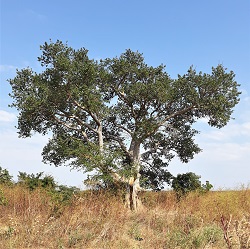
Ficus sycomorus (Sycamore Fig/Mukuyu Tree)
Beautiful yellow-green bark, Fruit attracts a host of birds species and wild animals. Very useful tree, improves infiltration rate and water-holding capacity of the soil, used for sand-dune fixation and riverbank stabilization, leaves and fruits are eaten by livestock, strong rope can be made from the inner bark, shed leaves form a valuable litter which may be used as a nutrient-rich mulch. Wood is used for timber and as firewood and charcoal
Full sun, Average water, drought tolerant, Any soil, 15 to 20 metres tall, Deciduous, Fast growing, Massive root system, not suitable as a street tree or near buildings
1 m tree K100
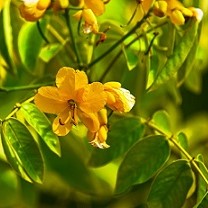
Spectacular ornamental tree for gardens and parks, Street and driveway liner, Spectacular in flower during autumn and early winter. Wood is hard, heavy, durable, termite resistant; perfect to make tool handles, produces good quality firewood, fodder for sheep and goats
Full sun, Average water, drought tolerant, Any soil,8 to 10 m high, Deciduous, Average to fast growing speed, Root system is not aggressive
1.5 m tree K180
2 m tree K320
2.5 m tree K550
3 m tree K900
